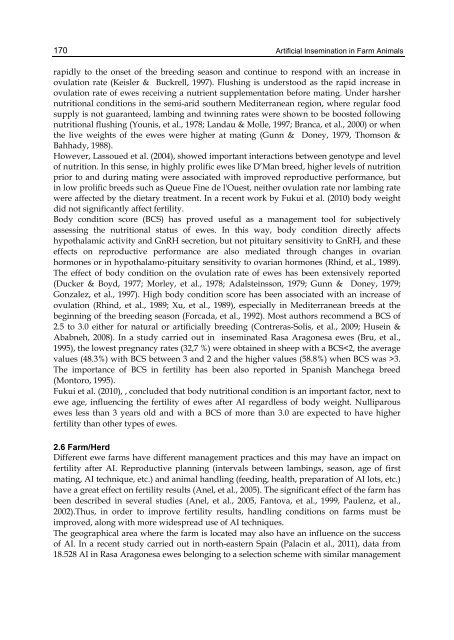ARTIFICIAL INSEMINATION IN FARM ANIMALS - Phenix-Vet
ARTIFICIAL INSEMINATION IN FARM ANIMALS - Phenix-Vet
ARTIFICIAL INSEMINATION IN FARM ANIMALS - Phenix-Vet
You also want an ePaper? Increase the reach of your titles
YUMPU automatically turns print PDFs into web optimized ePapers that Google loves.
170Artificial Insemination in Farm Animalsrapidly to the onset of the breeding season and continue to respond with an increase inovulation rate (Keisler & Buckrell, 1997). Flushing is understood as the rapid increase inovulation rate of ewes receiving a nutrient supplementation before mating. Under harshernutritional conditions in the semi-arid southern Mediterranean region, where regular foodsupply is not guaranteed, lambing and twinning rates were shown to be boosted followingnutritional flushing (Younis, et al., 1978; Landau & Molle, 1997; Branca, et al., 2000) or whenthe live weights of the ewes were higher at mating (Gunn & Doney, 1979, Thomson &Bahhady, 1988).However, Lassoued et al. (2004), showed important interactions between genotype and levelof nutrition. In this sense, in highly prolific ewes like D’Man breed, higher levels of nutritionprior to and during mating were associated with improved reproductive performance, butin low prolific breeds such as Queue Fine de l'Ouest, neither ovulation rate nor lambing ratewere affected by the dietary treatment. In a recent work by Fukui et al. (2010) body weightdid not significantly affect fertility.Body condition score (BCS) has proved useful as a management tool for subjectivelyassessing the nutritional status of ewes. In this way, body condition directly affectshypothalamic activity and GnRH secretion, but not pituitary sensitivity to GnRH, and theseeffects on reproductive performance are also mediated through changes in ovarianhormones or in hypothalamo-pituitary sensitivity to ovarian hormones (Rhind, et al., 1989).The effect of body condition on the ovulation rate of ewes has been extensively reported(Ducker & Boyd, 1977; Morley, et al., 1978; Adalsteinsson, 1979; Gunn & Doney, 1979;Gonzalez, et al., 1997). High body condition score has been associated with an increase ofovulation (Rhind, et al., 1989; Xu, et al., 1989), especially in Mediterranean breeds at thebeginning of the breeding season (Forcada, et al., 1992). Most authors recommend a BCS of2.5 to 3.0 either for natural or artificially breeding (Contreras-Solis, et al., 2009; Husein &Ababneh, 2008). In a study carried out in inseminated Rasa Aragonesa ewes (Bru, et al.,1995), the lowest pregnancy rates (32,7 %) were obtained in sheep with a BCS3.The importance of BCS in fertility has been also reported in Spanish Manchega breed(Montoro, 1995).Fukui et al. (2010), , concluded that body nutritional condition is an important factor, next toewe age, influencing the fertility of ewes after AI regardless of body weight. Nulliparousewes less than 3 years old and with a BCS of more than 3.0 are expected to have higherfertility than other types of ewes.2.6 Farm/HerdDifferent ewe farms have different management practices and this may have an impact onfertility after AI. Reproductive planning (intervals between lambings, season, age of firstmating, AI technique, etc.) and animal handling (feeding, health, preparation of AI lots, etc.)have a great effect on fertility results (Anel, et al., 2005). The significant effect of the farm hasbeen described in several studies (Anel, et al., 2005, Fantova, et al., 1999, Paulenz, et al.,2002).Thus, in order to improve fertility results, handling conditions on farms must beimproved, along with more widespread use of AI techniques.The geographical area where the farm is located may also have an influence on the successof AI. In a recent study carried out in north-eastern Spain (Palacin et al., 2011), data from18.528 AI in Rasa Aragonesa ewes belonging to a selection scheme with similar management










